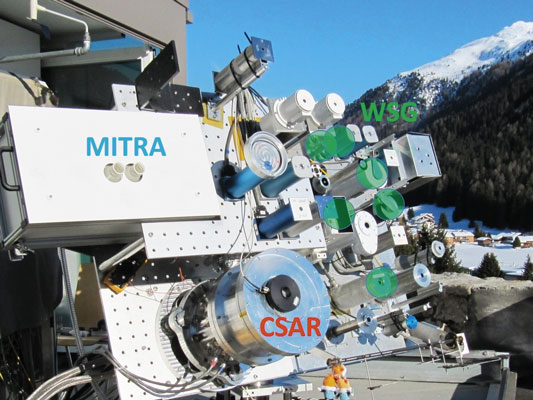SOLAR RADIOMETRY
World Standard Group (WSG)
The World Standard Group (WSG) is a group of six cavity pyrheliometers which define the World Radiometric Reference (WRR). The WRR was first defined in 1977 by averaging the simultaneous readings of the best characterised . . .
CSAR & MITRA
The Cryogenic Solar Absolute Radiometer (CSAR) will most probably become the new World Radiometric Reference (WRR) for Direct Normal Irradiance (DNI) measurements, and will replace the currently used World Standard Group (WSG) in the future.
International Pyrheliometer Comparisons (IPC)
The PMOD/WRC was mandated by the WMO to manage the World Standard Group (WSG) of solar irradiation instruments, and is responsible for the international dissemination of this standard. The WSG was defined by a group of Absolute . . .
The Solar Radiometry Section (SRS) of the WRC maintains and operates the World Standard Group (WSG) of Pyrheliometers which represents the World Radiometric Reference (WRR) for ground-based total solar irradiance measurements. The SRS also runs the calibration laboratory for solar radiometers (pyrheliometers and pyranometers), which issues over 100 calibration certificates each year. Research and development projects at the SRS are mainly focused on absolute radiometers for space and ground-based use.
Solar radiometers are used for climate research and for solar energy applications. The solar radiation that hits the earth is recognised by the World Meteorological Organisation (WMO) as an Essential Climate Variable (ECV). Measuring the solar irradiance is also important for selecting sites for solar power plants and to monitor their perfomance.
Solar (shortwave) radiometers measure direct irradiance from the Sun, which approximately corresponds to the Planck-spectrum at 5512°C. Solar irradiance is measured with pyrheliometers for direct solar radiation and with pyranometers for global radiation (direct solar radiation and diffuse radiation from the ground and the atmosphere) or diffuse radiation (shaded pyranometer). Absolute cavity radiometers are pyrheliometers with an open cavity receiver, which ensures a high absorptivity over the full spectral range. Pyranometers and field-pyrheliometers have a glass dome or window, respectively, to protect the blackened thermopile detector.
The WSG consists of six absolute cavity pyrheliometers and is operated on sunny days. Together with partners in Switzerland and the UK the SRS has built the Cryogenic Solar Absolute Radiometer (CSAR) and Monitor for Integrated Transmittance (MITRA). CSAR is a radiometer which operates in a vacuum tank at ~25 K, while MITRA is used to correct for the attenuation introduced by the entrance window to the vacuum tank. CSAR and MITRA operate in parallel and will form a new standard for solar irradiance to replace the WSG in the future.
International Pyrheliometer Comparisons (IPC) have been held every five years since 1959. During IPCs, regional and national reference radiometers from all over the world are compared to the WSG. The IPCs also see growing interest from solar energy related institutions. IPC-XIII occurred from September to October 2021.
- Guarantee world-wide homogeneity of meteorological radiation measurements by maintaining the World Standard Group which is used to establish the World Radiometric Reference.
- Calibration of meteorological radiation instruments.
- Research and development in radiometry and methods of observation of atmospheric radiation parameters.
- Training of radiation specialists.



